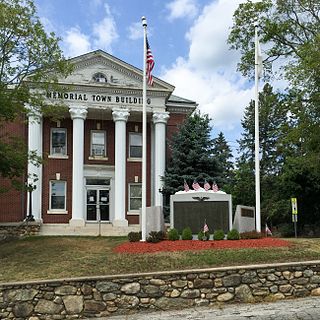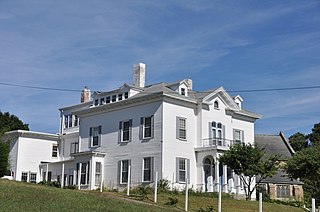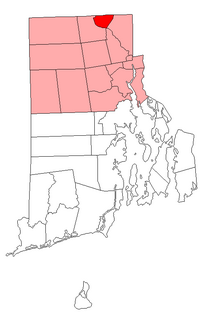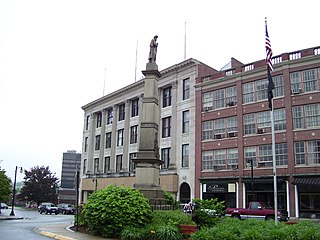
Woonsocket, is a city in Providence County, Rhode Island, United States. The population was 41,186 at the 2010 census, making it the sixth largest city in the state. Being Rhode Island’s northernmost city, Woonsocket lies directly south of the Massachusetts state line and constitutes part of both the Providence metropolitan area and the larger Greater Boston Combined Statistical Area.

Slatersville is a village on the Branch River in the town of North Smithfield, Rhode Island, United States. It includes the Slatersville Historic District, a historic district listed on the National Register of Historic Places. The historic district has been included as part of the Blackstone River Valley National Historical Park. The North Smithfield Public Library is located in Slatersville.

The 1761 Milestone is a mile marker located at 640 South Main Street in Woonsocket, Rhode Island. The stone originally marked the junction of a Colonial highway from Great Road and an east-west route from Boston, Massachusetts to Connecticut. It was rediscovered during the installation of an electrical road. In 1898, it was restored to its original location by the local chapter of the Daughters of the American Revolution. The stone is embedded in a low retaining wall at the corner of South Main Street and Smithfield Road. It was added to the National Register of Historic Places on November 24, 1982, and is historically significant as a Colonial-era highway marker.

The Woonsocket City Hall, is located in Woonsocket, Rhode Island.

The Cato Hill Historic District is a residential historic district in central Woonsocket, Rhode Island. It consists of about 2-1/2 blocks of Church and Cato Streets, as well as the streets crossing them. The area, located on a hill just above Woonsocket's downtown area, is a densely populated area built primarily between 1838 and 1875, during Woonsocket's growth as a major textile processing center. Cato Hill is named for Cato Aldrich, an African American who purchased the land from the Arnolds who founded Woonsocket. The houses of the district exhibit vernacular forms of the architectural styles popular in the mid-19th century.

The Henry Darling House is an historic house located at 786 Harris Avenue in Woonsocket, Rhode Island. The two-story wood frame house was constructed in 1865 by Henry Darling, a farmer, and was at that time on the rural outskirts of Woonsocket.

The Glenark Mills or Glenark Landing is a historic textile mill complex on 64 East Street in Woonsocket, Rhode Island. The original stone section of this mill was constructed 1865 by William Norton and was enlarged with a brick addition in 1885. Originally a cotton mill, the building was converted for use as a knitting mill and then as a worsted mill. It was added to the National Register of Historic Places in 1989.

The Grove Street Elementary School is an historic school at 312 Grove Street in Woonsocket, Rhode Island. The two-story brick Stick/Eastlake style school was designed by E.L. Angell of Providence and built in 1876. In c. 1885 it was enlarged by adding a matching addition to its rear, joined by a small hyphen. This addition is more Queen Anne in its styling.

The Island Place Historic District is a historic district at Island Place and South Main Street at Market Square in Woonsocket, Rhode Island. The district includes six historic buildings, three of which are part of the Woonsocket Rubber Company Mill, dating from c. 1857 to c. 1919. The other buildings in the district are the Island Machine Company, the Barnai Worsted Company Dyeworks, and a wood-frame structure, that is the last surviving elements of the Wilkins Manufacturing Company. The district is bounded by Market Square, Bernon Street, and a bend in the Blackstone River. The site is now home to the Museum of Work & Culture, a project of the Rhode Island Historical Society.

The Main Street Historic District is a historic district in the central business district of Woonsocket, Rhode Island, USA. It extends along Main Street, between the railroad tracks just northeast of its junction with Clinton Street, and roughly Ascension Street at the southwest. Most of the sixteen buildings in this area were built at the height of Woonsocket's prosperity, roughly between 1850 and 1930. The district is characterized by brick and masonry buildings generally between two and six stories in height.

The North End Historic District is a historic district in Woonsocket, Rhode Island encompassing an affluent residential area developed predominantly between about 1880 and 1930. It is bounded by Harris Avenue on the west, Winter Street on the north, Summer and Prospect Streets to the east, and Spring and Blackstone Streets to the south. It is separated from Woonsockets commercial and industrial heart by a neighborhood of densely populated worker housing. Most of the district's 224 major buildings are of relatively high quality and in good condition, and are reflective of the architectural styles that predominated in the late 19th and early 20th centuries: Queen Anne Victorian, Colonial Revival, and Tudor Revival forms and styles are the most common seen.

Woonsocket Rubber Company Mill is an historic mill at 60-82 Main Street in Woonsocket, Rhode Island. The mill consists of a series of 3- and 4-story brick buildings built between 1865 and 1875 by Edward Harris, one of Woonsocket's leading businessmen. These buildings housed the Woonsocket Rubbert Company, one of Rhode Island's first manufacturer of rubber products, principally shoes, boots, and rubberized fabric. In 1910 the complex was purchased by the Falls Yarn Company, which used it for the production of fine woolen yarns.

The Woonsocket District Courthouse is an historic court building on 24 Front Street in Woonsocket, Rhode Island.

The Woonsocket Company Mill Complex is a historic district encompassing one of the largest mill complexes in Woonsocket, Rhode Island. The district includes all of the buildings historically associated with the Woonsocket Company, a major manufacturer of cotton textiles in the 19th century. The complex is located along the eastern bank of the Blackstone River between Court and Bernon Streets. It includes three handsome stone mills, built between 1827 and 1859, and a power plant that was built on the site of the former #3 mill between 1890 and 1920, as well as the remnants of the canal that originally carried water to the buildings for power.

The St. Charles Borromeo Church is a former Roman Catholic parish church in Woonsocket, Rhode Island, located on North Main Street. The parish of St. Charles was canonically suppressed January 12, 2020 and the congregation merged with that of the Church of All Saints, another parish of the Diocese of Providence, although the church remains open as an alternative worship space.

St. Ann's Church Complex is now a historic cultural center in Woonsocket, Rhode Island on Cumberland Street. It was formerly a Roman Catholic church within the Diocese of Providence.

St. Andrew's Episcopal Chapel is an historic Episcopal church located at 576 Fairmont Street in Woonsocket, Rhode Island.

This is a list of National Register of Historic Places listings in Woonsocket, Rhode Island.

The American Brewing Company Plant, owned by the American Brewing Company, is a historic brewery complex at 431 Harris Avenue in Providence, Rhode Island that operated between 1892 and 1922. It is a well-preserved example of a state of the art late 19th century brewery building, its original functions still discernible in its layout. It was only used as a brewery until 1922, when it was shut down by Prohibition; it has served as a warehouse and storage facility for most of the time since. The complex was listed on the National Register of Historic Places in 2016.

The L'Union Saint Jean-Baptiste d'Amerique is a historic building at 1 Social Street in Woonsocket, Rhode Island. Built in 1926, it housed a fraternal benefit society for French Canadian Roman Catholic immigrants for many years, serving a significant immigrant population in the community. The building is also a prominent example of Classical Revival architecture, designed by a French Canadian immigrant architect, Walter Fontaine. The building was listed on the National Register of Historic Places in 2018.





















